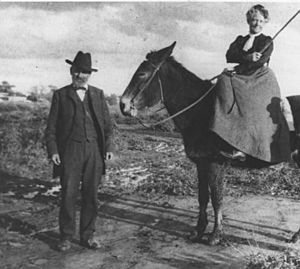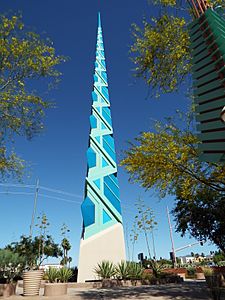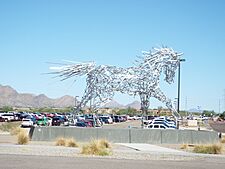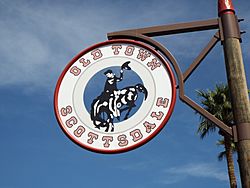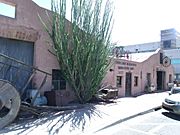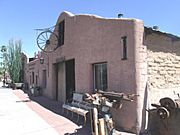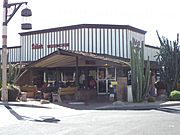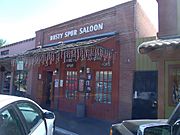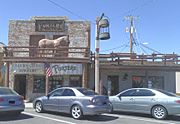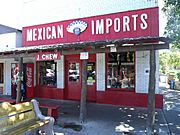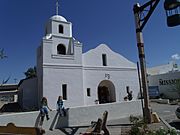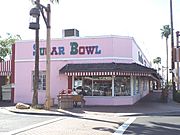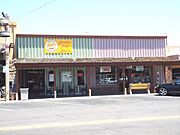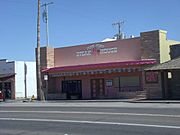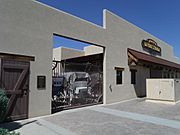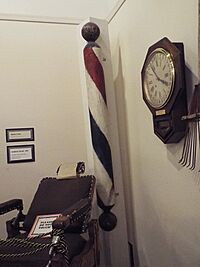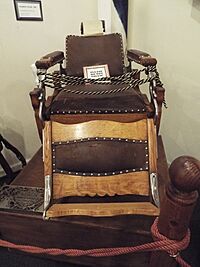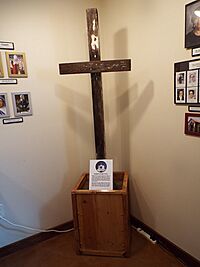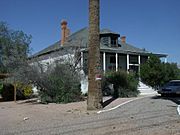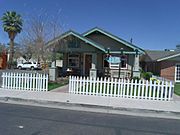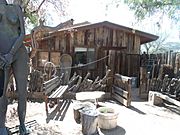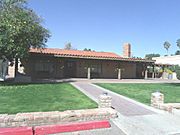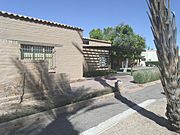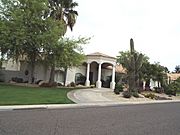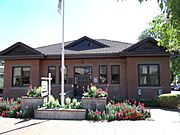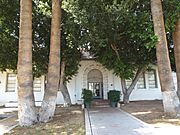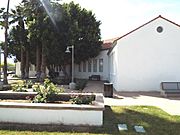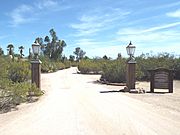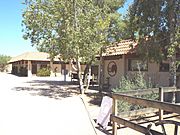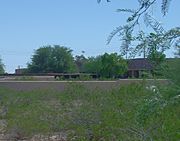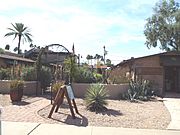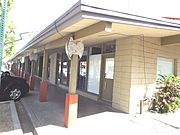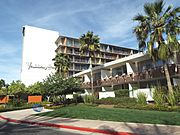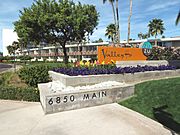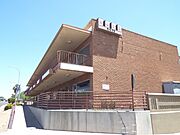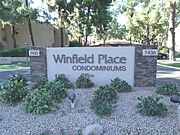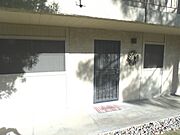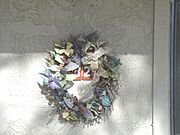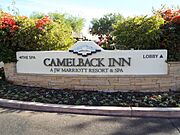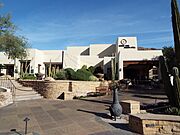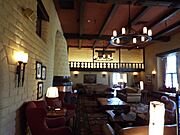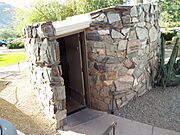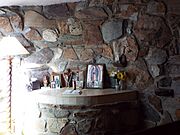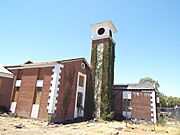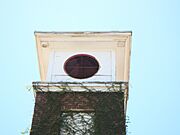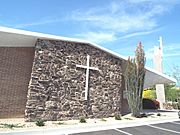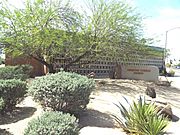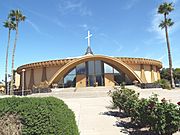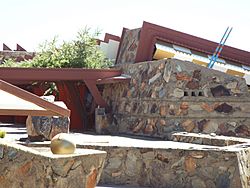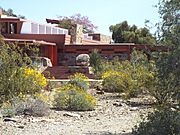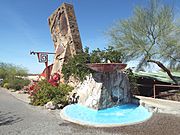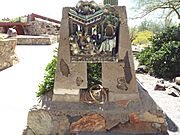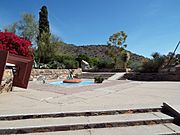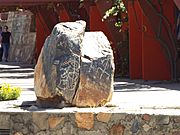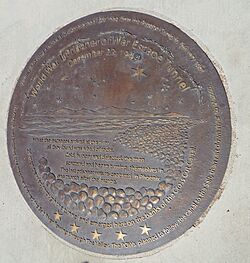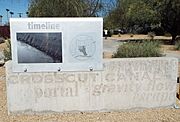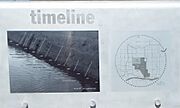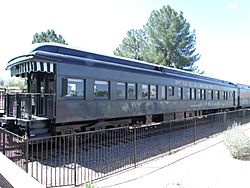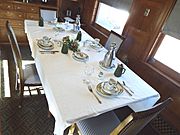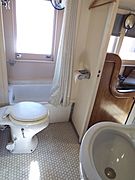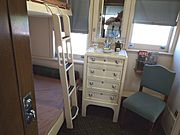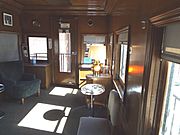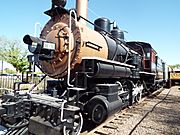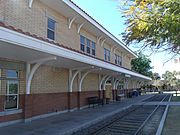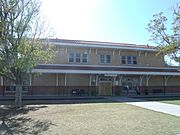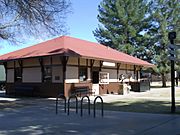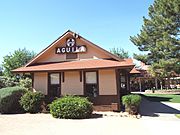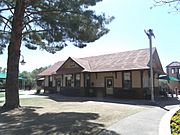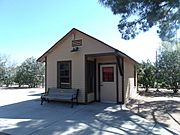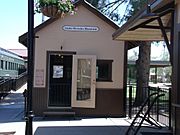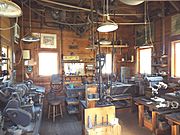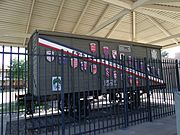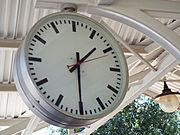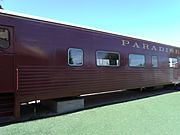List of historic properties in Scottsdale, Arizona facts for kids
Quick facts for kids
List of historic properties
in Scottsdale, Arizona |
|
|---|---|
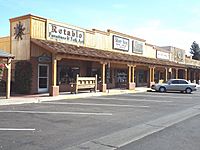
East 1st Avenue in Old Town Scottsdale.
|
|
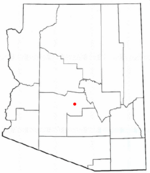
Location in Maricopa County and the state of Arizona
|
Scottsdale, Arizona, is a city with a rich history! This article will take you on a journey through some of its most important and oldest buildings and places. You'll see photos of these historic spots. Some of them are so special they are listed on the National Register of Historic Places. Others are recognized by the Scottsdale Historic Register. Let's explore Scottsdale's past!
Contents
A Quick Look at Scottsdale's History
Scottsdale was started by a man named Winfield Scott. He was a chaplain in the U.S. Army. In 1888, he moved to this area with his wife, Helen, and his brother, George. Winfield Scott believed the land was perfect for farming. He bought 640 acres for just $3.50 an acre. This is where Downtown Scottsdale is today!
The Scott family and other early settlers first called their small town Orangedale. This was because the Scott brothers planted many citrus trees. They also grew figs, potatoes, peanuts, and almonds. In 1894, the people decided to change the town's name to Scottsdale, honoring its founder. The town officially became a city in 1951 and grew very quickly. Many old buildings still stand in a part of town called "Old Town Scottsdale." This area is where the original town was located.
A famous architect named Frank Lloyd Wright also spent his winters in Scottsdale. In 1931, he built his winter home and school, Taliesin West. While building, workers found ancient Hohokam petroglyphs (rock carvings). Some of these carvings still decorate the property today. Wright lived there from 1931 until he passed away in 1959. Taliesin West is now a very important historic place.
The city of Scottsdale has a special program to protect its history. It's called the Scottsdale Historic Preservation Program. Their goal is to help everyone learn about Scottsdale's past. They also find and protect important old buildings. This helps make sure these special places last for a long time. They have recognized several areas as historic districts, like Village Grove, Town and Country Scottsdale, and Villa Monterey.
Old Town Scottsdale's Historic Buildings
Old Town Scottsdale is the heart of the city's history. Many of its original buildings are still standing. Here are some of the interesting historic buildings you can find there:
- Cavalliere's Blacksmith Shop: This shop was built in 1920. It's located on N Brown Ave. It's one of the oldest businesses in Old Town.
- The Sterling Drug Store building: Built in 1921, this building is now home to Saba's Department Store. It's on the corner of N. Brown Avenue and E. 1st Avenue.
- Farmer's State Bank: This building from 1921 now houses the Rusty Spur Saloon. You can find it on E Main St.
- The First U.S. Post Office Building: Built in 1929, this building now has Porter's Western Store inside. It's on North Brown Avenue.
- Johnny Rose's Pool Hall: This building was built in 1923. Today, it's the Mexican Imports store on N Brown Ave.
- "Our Lady of Perpetual Help Church": This historic adobe church was built in 1933. It's on N. Brown St. It's listed on both the Scottsdale Historic Register and the National Register of Historic Places.
- The Western Motor Service building: Built in 1950, this building is now the Sugar Bowl Restaurant. It's on the corner of N. Scottsdale Road and E. 1st Avenue.
- The Lu Lu Belle Building: This building was built in 1953. It used to be a fun bar and diner with a "Gay Nineties" theme.
- Sprouse-Reitz Drugstore: Built in 1954, this building now houses the Pink Pony Steak House. It's on N Scottsdale Rd.
- Noriega's Home and Livery Stable: This building was built in 1920. It belonged to the Noriega family, who were among Scottsdale's first settlers. It's on N. Brown Ave.
Monuments you can see:
- The Scottsdale Spire: This tall, unique monument was designed by Frank Lloyd Wright. Its construction started in 1957. It was finally finished in 2007 by his students.
- Impulsion: This is a huge metal horse sculpture by artist Jeff Zischke. It was revealed in 2014 at WestWorld. The name "Impulsion" describes how a horse moves forward with controlled power.
Historic Structures in Pictures
Here are more images of historic buildings in Scottsdale and nearby areas.
Buildings on Historic Registers
Many historic buildings in Scottsdale are listed on special registers. These include the National Register of Historic Places and Scottsdale's own Historic Register. Being on these lists means they are important and protected. Here are some of them:
- The Frank Tilus House: Built in 1875, this is a very old house in Scottsdale. It was added to the National Register in 1982.
- The Charles Miller House: This house in Old Town Scottsdale was built in 1913. It's on Scottsdale's Historic Register.
- The George Ellis House: Built in 1925, this house is also listed on the National Register of Historic Places.
- The Louise Lincoln Kerr House: Built in 1925, Louise Lincoln Kerr was a big supporter of music in the area. Her house is on the National Register.
- The Walter Winchell House: Built in 1954, this was the home of Walter Winchell, a famous newspaper writer.
- The Scottsdale Grammar School, also known as "The Little Red Schoolhouse": This school was built in 1909. It's a beloved historic landmark and is on the National Register.
- The Scottsdale Grammar School #2, or Loloma Elementary: Built in 1928, this school is on Scottsdale's Historic Register.
- The Cattle Track Complex: This group of buildings was built between 1937 and 1940. It's on Scottsdale's Historic Register.
- The Valley Field Riding and Polo Club: Built in 1924, this club was once a place for horse riding and polo. It's now abandoned but is on the National Register.
- The Adobe Apartments: These apartments were built in 1953 and are on Scottsdale's Historic Register.
- Craftsman Court: This area was developed between 1955 and 1958. It's on Scottsdale's Historic Register.
- The Hotel Valley Ho: This famous hotel was built between 1956 and 1958. It's on Scottsdale's Historic Register.
- The Nuss Building: Built in 1960, this building in downtown Scottsdale houses various small businesses.
- The Camelback Inn: This beautiful inn was built in 1936. You can also see the original Rita's Kitchen dining room there.
- The Camelback Inn Chapel: This chapel was also built in 1936, right next to the Inn.
- The Church of Jesus Christ of Latter-day Saints (LDS): Built in 1958, this church is one of the oldest in Scottsdale. It once had a large clock tower.
- The Holy Cross Lutheran Church: Built in 1960, this church is on Scottsdale's Historic Register.
- The First Church of Christ, Scientist building: Built in 1962, this church is also on Scottsdale's Historic Register.
- The Glass and Garden Community Church: Built in 1966, this church is on Scottsdale's Historic Register.
- Scottsdale's properties in the National Register of Historic Places
and/or Scottsdale's Historic Register
Taliesin West: Frank Lloyd Wright's Desert Home
Taliesin West was built in 1931. It was the winter home and school of the famous architect Frank Lloyd Wright. He lived and worked here in the desert from 1931 until he passed away in 1959. Taliesin West is a very important example of his unique style of architecture. It is listed on the National Register of Historic Places.
The Great Papago Escape: A WWII Story
During World War II, the United States had a prisoner-of-war (POW) camp in the Papago desert near Scottsdale. It was called Camp Papago Park. Most of the prisoners were German U-boat (submarine) sailors. One of them was a commander named Jürgen Wattenberg.
The prison guards didn't know that Wattenberg and some of his men were secretly digging a tunnel! The tunnel would lead out near the Crosscut Canal. The guards thought the prisoners were just building a soccer field. The prisoners planned to use boards to travel along the Gila River to the Colorado River, hoping to reach Mexico and freedom. However, they didn't realize that the rivers in Arizona were dry at that time of year.
On the night of December 23, 1944, the commander and 24 of his men made their escape. When they came out of the tunnel, they found a dry riverbed! Eventually, they were all caught and returned to the POW camp. This event, known as the Great Papago Escape, was the largest escape of its kind in U.S. history.
McCormick-Stillman Railroad Park: Trains and History
The McCormick-Stillman Railroad Park is a fun place with a lot of history! It's home to the Roald Amundsen Pullman Private Railroad Car, which was built in 1928. This special train car reportedly carried several U.S. Presidents, including Hoover, Roosevelt (FDR), Truman, and Eisenhower! It's listed on the National Register of Historic Places.
-
The Swiss Railway Clock donated to the McCormick-Stillman Railroad Park by the City of Interlaken, Switzerland. This was done in commemoration of the sister cities partnership of the cities of Interlaken and Scottsdale. The Swiss Railway Clock was designed in 1944 by Hans Hilfiker and was used by the Swiss federal Railways as a station clock.
See also


